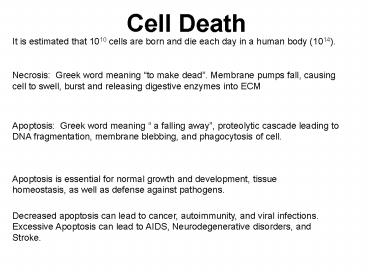Cell Death PowerPoint PPT Presentation
1 / 29
Title: Cell Death
1
Cell Death
It is estimated that 1010 cells are born and die
each day in a human body (1014).
Necrosis Greek word meaning to make dead.
Membrane pumps fall, causing cell to swell, burst
and releasing digestive enzymes into ECM
Apoptosis Greek word meaning a falling away,
proteolytic cascade leading to DNA fragmentation,
membrane blebbing, and phagocytosis of cell.
Apoptosis is essential for normal growth and
development, tissue homeostasis, as well as
defense against pathogens.
Decreased apoptosis can lead to cancer,
autoimmunity, and viral infections. Excessive
Apoptosis can lead to AIDS, Neurodegenerative
disorders, and Stroke.
2
Ultrastructural Features of Apoptosis
3
Cell Lineage in the C. elegans embryo
4
Conserved Apoptotic Pathway
Nature Structural Biology 8, 394 - 401 (2001)
5
The Caspase Family
6
(No Transcript)
7
(No Transcript)
8
(No Transcript)
9
(No Transcript)
10
Science. 1998 Aug 28281(5381)1309-12
11
(No Transcript)
12
(No Transcript)
13
The Integrated Apoptotic Pathways
14
The Tumor Necrosis Factor Receptor Family
TNFRI
PV-A53R
Fas
PV-T2
Dr3
Dr4
TRID OPG
Dr5
Dr6
DEATH DOMAIN
15
Death Domains
FADD
TRADD
FADD
Death Effector Domains
TRAF2
RIP
mitochondria
Caspase-8
Type II
Type I
Survival signals
Immune Inflammatory Responses
Apoptosis
16
Rel - Ankyrin Family
Dimerization
DNA-Binding
NLS
c-Rel
RelA (p65)
RelB
NF-
?
B1
p105 (p50)
NF-
?
B2
p100 (p52)
I
?
B-
?
I
?
B-
?
I
?
B-
?
I
?
B-
?
Bcl-3
17
(No Transcript)
18
Death Domains
TIM Domains
TRAF Proteins
TRADD
RIP
?
?
?
NIK
?
p38a
PI3K
ERK1/2
IKKg
IKKa
IKKb
ASK1
GCK/GCKR
MKK4/7
type 1
type 2
JNK
IkBa
p100
p65
p105
p52
fos
p65
p50
RelB
Jun
Immune and Inflammatory Responses
19
NF-
?
B regulates a broad range of genes.
GGG
RNNYY
CC
S
u
r
f
a
c
e
R
e
c
e
p
t
o
r
s
A
c
u
t
e
P
h
a
s
e
angiotensin
GGGATTTCCC
Ig
??
light chain
GGGACTTTCC
complement factor B
GGGAATCCCC
IL-2R
?
chain
GGGAATCTCC
complement C4
GGGAAGTCCC
TCR
??
chain
GGGAGATTCC
b
Serum amyloid A
GGGACTTTCC
MHC class I (H-2K )
GGGGATTCCC
invariant chain Ii
GGGAATTTCC
Apoptosis
?
-2 microglobulin
GGGACTTTCC
MHC class II (E
?
, E
?
)
GGGACTTCCC
c-myc
GGGAAAACCC
Bcl-x
GGGACTGCCC
Bfl-1
Cytokines
GGGGATTTAC
GGGATTTCAC
IL-2
Viruses
GGGATTTTCC
IL-6
GGGACTTTCC
GGAATTTCCT
HIV
IL-8
GGGACTTTCC
GGGAACTACC
GM-CSF
GGGACTTTCC
GGGGAATCTC
G-CSF
SV40
GGGAAGTACC
several
TNF-
??
(cachectin)
GGGACTTTCC
GGGGCTTCCC
TNF-
?
(lymphotoxin)
cytomegalovirus
GGGGATTTCC
GGGAAATTCC
?
-interferon
GGGACTTTCC
GGGACGTCCC
adenovirus
proenkephalin
20
NF-?B-Regulated Genes Inhibit TNF-?-Mediated Cell
Death
21
TNF-?-Mediated Upregulation of Bcl-x and Bfl-1
Requires NF-?B Activity
42-7-8
A549
15
30
15
30
0
0
TNF-? (min)
0
2
4
0
2
4
TNF-? (hrs)
22
The Bcl-x NF-?B Cis Element is Capable of RelA
Mediated Transcriptional Activation
NF-?B Cis Element
Bcl-x WT Promoter
23
Establishing 42-7-8 Cell Lines Expressing Bcl-x
or Bfl-1 at Physiological Levels
24
I?B-Expressing Cells are Sensitized
to TNF-?-Mediated Cell Death, which is Inhibited
by Expression of Bcl-x or Bfl-1
MTT ASSAY
25
CD40 Survival Signaling through NF-kB-Mediated
Upregulation of Bcl-x and Bfl-1
Caspase Activity
Apoptosis
Fas
26
Chemotherapy Drugs Differentially Upregulate the
Expression of Bcl-x and/or Bfl-1 through an
NF-kB-dependent Pathway
27
A549 Cells Are Sensitized to Chemotherapy-Mediated
Apoptosis Upon Inhibition of NF-?B Signaling
120
100
VP-16
CDDP
100
80
80
60
60
40
40
20
20
0
0
?g/ml
?M
300
0
0
200
400
2.5
5
7.5
10
Percentage of Cell Survival
100
100
Adriamycin
80
60
40
20
0
0
10
20
30
40
?M
28
The Enhancement of Chemotherapy-Induced
Cell Death Through Manipulation of Signaling
Pathways
Pro-apoptotic signal
Death
Chemotherapy
Anti-apoptotic signal 1. NF-?B-Mediated
Upregulation of Bcl-2 Family Members 2. Other
pathways (AP-1?)
Pro-apoptotic signal
Enhanced Death
Chemotherapy
Anti-apoptotic signal 1. NF-?B-Mediated
Upregulation of Bcl-2 Family Members 2. Other
pathways (AP-1?)
29
Death Domains
Ubiquitination
TIM Domains
FADD
TRADD
FADD
RIP
FLIP
TRAF Proteins
Caspase 8/10
Type II
Bcl-x/A1
JNK Activation
NF-kB Activation
Type I
Caspase 3/6/7
Bcl-2/Bcl-X cIAP-1/c-IAP-2 FLIP
Activation Differentiation
IAPs
Apoptosis

